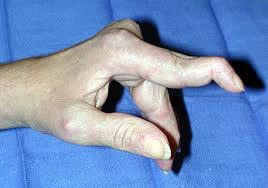What is Carpal Tunnel Syndrome (CTS)?
Carpal Tunnel Syndrome (CTS) involves compression of the median nerve at the wrist. The finger tendons, blood vessels and median nerve extend from the forearm to the fingers through a small tunnel (surrounded by bone) in the wrist, named the carpal tunnel. If any of the tendons in the carpal tunnel become swollen, the median nerve is pinched resulting in pain, numbness and tingling of the first three fingers of the hand. If CTS is not treated in its early stages, it can result in permanent disability. It is estimated that close to 1 million people in the United States annually may develop CTS, requiring medical care and leaving them at least temporarily disabled.1
What Causes CTS?
CTS can be caused by chronic diseases such as rheumatoid arthritis, gout, and diabetes. It has also been linked with pregnancy and birth control use. Exposure to workplace factors can also cause CTS. It is estimated that approximately 50% of all medically diagnosed cases of CTS are work-related.2,3
Work-related risk factors for CTS include repetitive and forceful exertions of the hands and wrists, combinations of either force or repetitive work and awkward hand postures, and exposure to hand vibration.4 Acute trauma to the wrist can also cause CTS.
Is Work-Related CTS Preventable?
Work related CTS (WR-CTS) is preventable. Prevention practices to reduce the risk of developing CTS are varied. Examples are:
•Adjusting your workstation so that you are working in the proper posture;
•Reducing the number of times per hour or a day you use your fingers and hands;
•Reducing the number and weight of forceful exertions such as lifting or pinching objects.
•Using well maintained, correctly sized tools.
Other prevention strategies involve changing work organization. These include, for example, reducing the pace of work, and making certain you take frequent rest breaks throughout the day.
What is known about work-related CTS in Massachusetts?
Since 1992, the Massachusetts Department of Public Health (MDPH), funded by the National Institute of Occupational Safety and Health, has conducted surveillance of work-related CTS in order to identify industries, occupations and workplaces where prevention efforts are needed. The Occupational Health Surveillance Program (OHSP) at the Department uses two data sources to identify cases of work-related CTS: 1) workers' compensation claims filed in Massachusetts with an injury code for "CTS"; and 2) case reports of confirmed and suspected work-related CTS filed by physicians in accordance with Massachusetts regulations requiring physicians to report select work-related conditions to MDPH.
Key Surveillance Findings
•Between March 1992 and June 1997, 4,837 cases of work-related-CTS were reported to OSHP.
•The highest rates of work-related CTS were found among workers in manufacturing industries. However, the largest numbers of cases were employed in technical, sales and administrative support occupations. Fifteen percent of the cases employed in manufacturing were employed in administrative/sales jobs.
•Data entry keyers, general office clerks, secretaries and cashiers appear on the list of occupations with both high numbers of cases and high rates of work-related CTS.
•Grocery stores were the single industry with the highest number of cases; cashiers made up 40% of the cases. Hospitals (a service industry) has the second highest number of cases. Secretaries make up 15% of the cases in the hospital industry.
•Over 300 cases were less than 25 years old, raising significant concern about the long term impact of work-related CTS on health and employment options of young workers who are just beginning their careers.
•Many more women in Massachusetts are getting work-related CTS than men. A number of factors likely account for this finding. Women may be more likely to select or be selected into high risk jobs. Underlying biological differences between men and women and gender differences in reporting injuries and seeking medical care are also possible factors.
•Over 70% of cases identified through workers' compensation who were interviewed have had surgery for their CTS and almost 70% reported CTS in both hands.
•Approximately 50% of the workers who attributed their CTS to keyboard use reported having had surgery for CTS and 50% reported CTS in both hands
1 Tanaka S, Wild D, Seligaman P, Behrens V, Cameron L and Putz-Anderson V.(1994):The US prevalence of self-reported carpal tunnel syndrome: 1988 national health interview survey data. Am J of Public Health 84(11):1846-1848.
2 Ibid.
3 Cummings H, Maizlish N, Rudolph L, Dervin K, Ervin A (1989): Occupational disease surveillance: Carpal tunnel syndrome. Morbidity and Mortality Weekly Report 38: 485-489.
4 Bernard B (1997): "Musculoskeletal disorders and workplace factors: A critical review of epidemiologic evidence for work-related musculoskeletal disorders of the neck, upper extremity, and low back." Cincinnati: Department of Health and Human Services, National Institute of Occupational Safety and Health
SOURCE
















